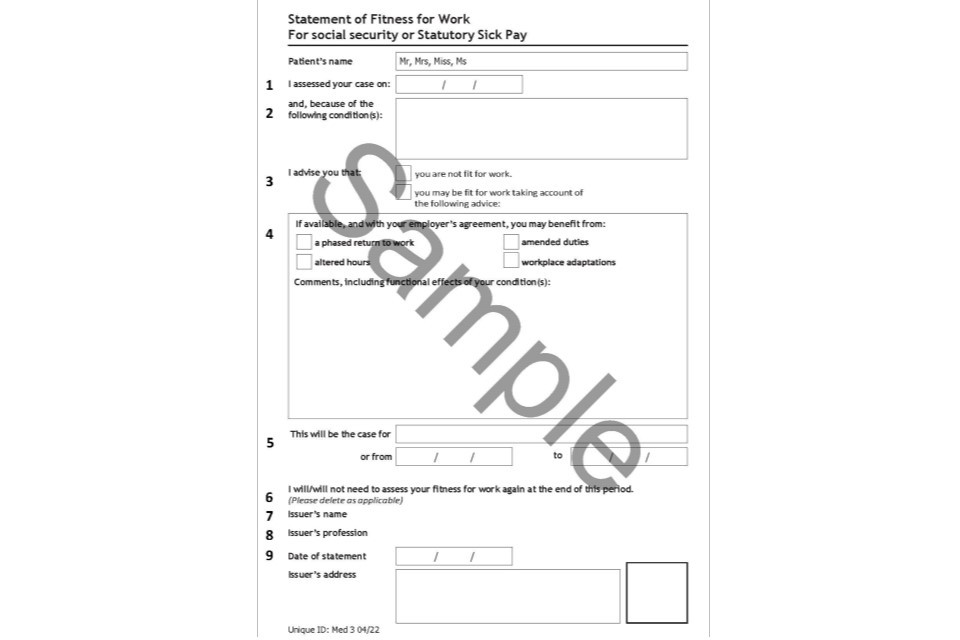Annex A – Fit note: Detailed guide for healthcare professionals completing the form
Updated 6 October 2023

Filling in the fit note: instructions for completion by GPs. Post April 2022 sample form.
When you issue a fit note from your patient, we recommend you to read the guidance for healthcare professionals, or type in www.gov.uk/fit-note. To ensure you follow the right steps each time, you can view, download or print out the Fit Note: Quick Reference Guide.
1. The date on which you assessed your patient; or on any day afterwards. This can be via either: a face-to-face or telephone/online consultation; it is also possible for a fit note to be based on a written report by another healthcare professional.
2. Describe the condition or conditions that affect your patient’s fitness for work. Give as accurate a diagnosis as possible, unless you think a precise diagnosis will damage your patient’s wellbeing or position with their employer.
3. You should only tick “you are not fit for work” if your patient cannot do any form of work at all. Always consider if your patient could do work of some kind and remember the long-term risks of worklessness when advising your patient that they are not fit for work.
You should tick “you may be fit for work” if your patient could do some form of work. This gives maximum flexibility to your patient and their employer to discuss ways to accommodate your patient’s condition at the workplace.
4. The comments box must be completed when you tick may be fit for work and may be useful to complete when you have ticked not fit for work.
Your advice should focus on what your patient can do at work with any relevant workplace modifications, rather than their diagnosis and symptoms. Your patient and their employer should then discuss possible adaptations and changes to accommodate your advice.
The important information to include in this box is advice about the functional effects of your patient’s condition on their fitness for work.
5. ndicate the period that your advice applies for. This may be the date that you expect your patient to have recovered by, or your judgement about an appropriate time to review their fitness for work even if they are unlikely to have fully recovered. In the first 6 months of a patient’s condition, a fit note can cover a maximum of 3 months. If a condition has lasted longer than 6 months, a fit note can be for any clinically appropriate period up to ‘an indefinite period’.
6. This section is mandatory – it gives your patient an indication about whether they can expect to be fit for work when the fit note expires, which helps them and their employer plan for the future. If you expect that your patient will be fit for work at the end of their fit note, indicate that you will not need to assess them again. If you don’t expect them to be fit for work, or you aren’t sure, indicate that you will need to assess them again.
7 and 8. Please insert the name of the issuer and profession. If you are using the computer-generated fit note, this will be completed automatically. If not, ensure that this section is filled in.
9. If you are using the computer-generated fit note, the date of statement and issuers address of your practice will be completed automatically. If not, ensure that these sections are filled in. This is the date that you issue the fit note – which may not necessarily be the same as the assessment date in box 1.
10. If you are completing an old template (Med3 2017), Fit note with signature in ink. Sign the fit note using ink. If you are a nurse, occupational therapist, pharmacist, or physiotherapist, you must strike out ‘doctors’ and replace with your own. Computer-generated fit note, the date of statement date and address of your practice will be completed automatically by your IT software. Ensure that these sections are filled in.
1. You should know…
You do not need to issue a fit note for the first 7 days of a patient’s sickness. Patients can self-certify for this period.
A duplicate fit note must be clearly marked as ‘duplicate’ and only be issued if the original has been lost.
